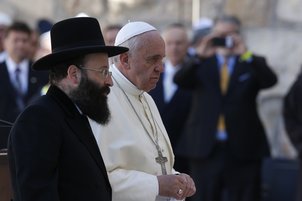
We reflect on supersessionism or replacement theology quite a lot in Christian – Jewish relations –because for many years the Christian Church claimed that because the Jews had rejected Jesus, God had rejected them and transferred the promise of being God’s People to Christians who were the true and faithful children of Abraham. I remember being taught about the idea of the anawim as I was growing up. The anawim were the faithful Jews (associated with Jesus, his mother and disciples), the small faithful remnant who were true to God’s promises and from whom Christianity emerged. Christianity, therefore, was a continuation of fidelity, not the legalism identified with the majority of Jews at the time of Jesus and certainly not those who had missed the coming of the Messiah. How arrogant it now sounds. Thank goodness we are now facing up to it. To believe that Christianity replaced Judaism led, in the past, to attitudes of rejection, a distortion of Judaism’s truth, marginalisation of the community and even violence. Today we are more aware of the Jewishness of Jesus and how the Christian scriptures reflect not conflict between Judaism and Christianity as established religions but tensions between Jews struggling to understand what it meant to be faithful to their Judaism while acknowledging the growing influence of those who chose to follow Jesus. In the Gospels it’s important to remember that all the people are Jews (unless otherwise stated). The break between the two religions did come about when Gentiles were admitted to the community of those who were followers of Jesus’ way and no demands were put on them to accept Jewish customs like circumcision and food laws. For the Jewish community this was a serious threat to their identity and for Christians not to accept Gentiles and see Jesus as the focus of their identity was a threat to what it meant to be Christian. So the two religions did go their own way, establishing separate identities with different practices and, when Constantine was converted in the 4thcy, establishing what we know of as Christendom, with different positions within society. And the superior and more powerful community made life difficult to say the least for the marginalised and smaller faith.
Nowadays we Christians are less likely to claim that God has withdrawn his promises from His Chosen People. It’s been suggested by Ed Kessler that as parents do not reject or stop loving their first born when another baby comes along so God does not withdraw his promises or lessen his love for his firstborn. If human beings love their children equally and completely, why would we suggest that God doesn’t? In 2015 the Catholic Church published a document entitled ‘The Gifts and Calling of God are irrevocable’ which is straight from the letter to the Romans chapter 11:29. The document states that Jews are on the path to salvation, are not the focus of Christian mission and are still in covenantal relationship with God. What’s interesting about the document is that it was published by the Pontifical Council for Christian Unity and not the Pontifical Council for Interreligious Dialogue as one might suppose. This reflects the close bond between Christians and Jews who are seen as having a special family relationship.
Christianity is not the only religion to be accused of supersessionism. Muslims feel the same with regard to both Judaism and Christianity. They recognise the followers of both religions as People of the Book but they believe that the revelation captured in the Torah and the Gospels to be inadequate, incomplete and even distorted. The complete, true revelation is contained in the Qur’an. There is much that’s similar in the holy books of the three faiths but different emphases and different versions of common stories. So Jesus is recognised as a prophet but not the image of the invisible God as Christians believe. Abraham was called to sacrifice his son but it was Ishmael, the son of Hagar and not Isaac, the son of Sarah. Theirs is the true story which takes precedence over other accounts. This can be difficult in dialogue. If one partner believes in their own truth and rejects the truth of the others there can be no real dialogue. There can be no equality or openness which is the foundation for good interfaith relations. It’s important to set aside one’s own convictions, talking from the basis of what we each believe and being willing to share not only insights but the message behind the various stories for surely each religion has a truth to share.
I’m sure other religions also see themselves as somehow superseding the religion that gave them birth. In other contexts we don’t talk about it too much but it’s good to face ourselves honestly about our sense of superiority to see if it lingers somewhere in our psyche.




 RSS Feed
RSS Feed
